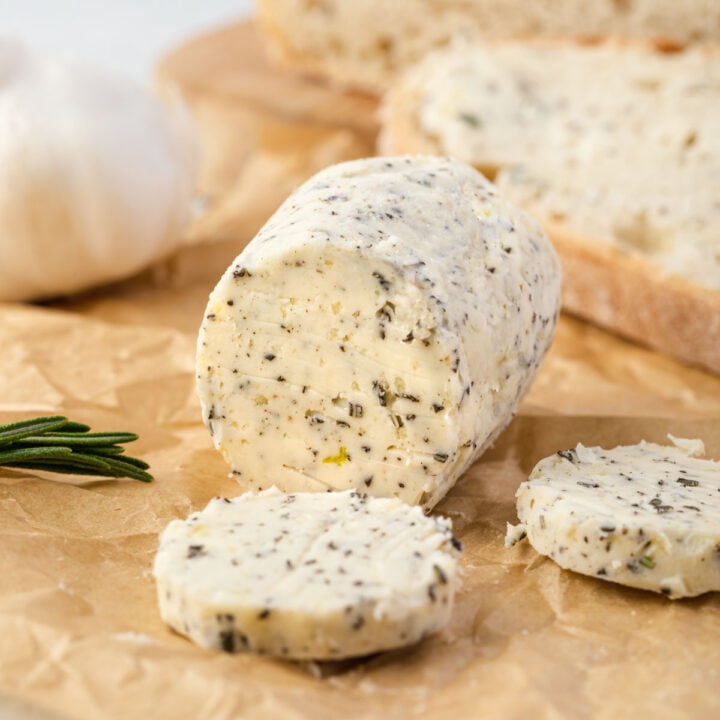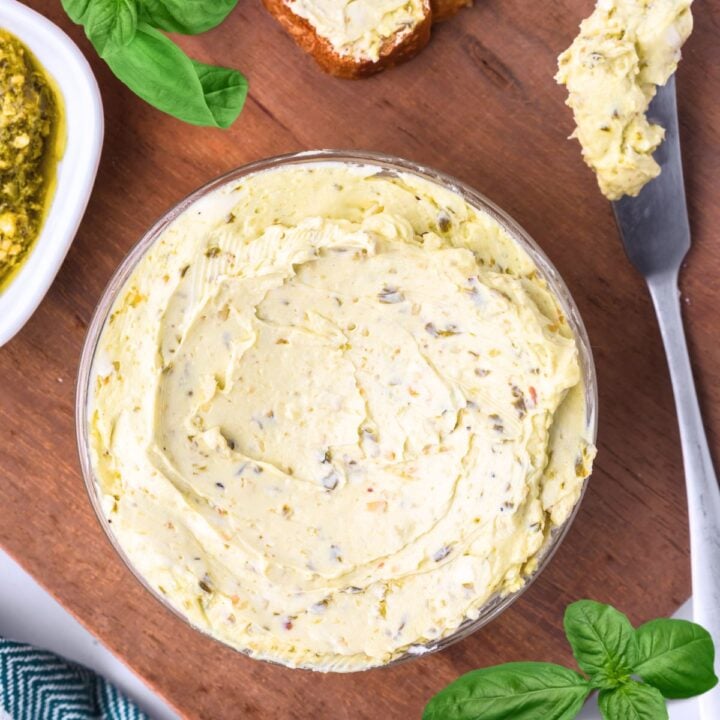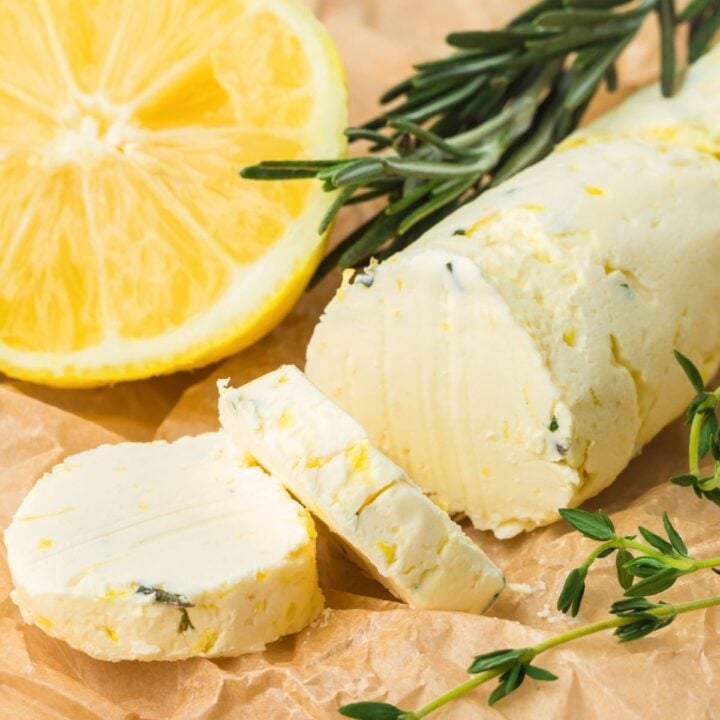Red wine butter adds a rich, savory flair that instantly makes any meal feel a little more special. This simple recipe uses a quick wine reduction to bring bold flavor into softened butter.

This red wine butter delivers way more flavor than you'd expect from a short ingredient list. It has a deep, savory richness that makes it perfect for special occasions.
Whether you’re topping a perfectly seared steak or spreading it on warm crusty bread, it adds an instant upgrade without any fuss.
The wine cooks down to a reduction that is balanced just right with the butter. No bitterness, no overpowering rosemary, just smooth, flavorful butter.
If you’ve never made compound butter before, this is a great place to start.
Ingredient and Substitution Info

Looking for the full recipe? The recipe card at the bottom of this post includes the complete list of ingredients, measurements, and instructions.
- Red Wine: A dry red like cabernet sauvignon or merlot works beautifully here. You don't need anything fancy, just something you enjoy drinking. The wine reduces to concentrate its flavor.
- Butter: Use unsalted butter so you can control the seasoning. Let it soften at room temperature so it blends smoothly with the wine reduction.
- Rosemary: Fresh rosemary brings an earthy, woodsy note that pairs perfectly with red wine. If you only have dried, use a small pinch and rub it between your fingers first to help release the oils.
- Garlic: Just a little adds savory depth without overpowering the butter. Fresh is best, but pre-minced garlic from the fridge will also work.
Tips to Make the Best Wine Butter

Make the Wine Reduction
- When you're simmering the wine, keep an eye on the pan. It can go from reducing to burning pretty quickly, especially near the end.
- You're aiming for about 2 tablespoons of liquid, which should look thick and slightly syrupy.
- If you're unsure, pour it into a small measuring cup to check, then return it to the pan if it needs to reduce more.
Let the wine mixture cool completely before adding it to the butter. If it's even slightly warm, it can melt the butter and make the texture oily instead of creamy. If you're in a hurry, pour the reduction into a shallow bowl and pop it in the fridge for a few minutes to speed things up.

Blend the Butter
- The butter should be soft but not melted. It won't mix smoothly if it's too cold; if it's too warm, the final texture can be greasy. It should give slightly when you press it with a finger.
- If you're doubling the recipe or prefer an extra smooth finish, you can use a hand mixer or food processor, but it's not required.
- Once everything is mixed, let it rest on the counter for about 15 minutes. This short wait gives the flavors a chance to settle and blend, which makes a noticeable difference in taste.
Make Ahead⏳
You can make the butter up to a week in advance and keep it refrigerated in an airtight container or wrapped in parchment as a butter log. It also freezes well. Just slice off what you need and let it soften before serving. This makes it a great option to prep ahead for holiday meals or dinner parties.

Ways to Use Cabernet Butter
This red wine compound butter has a bold, wine-forward flavor with a little bit of rosemary and garlic, so it pairs best with foods that can stand up to that richness.
Steak: This is the classic pairing. Melt a slice over grilled or pan-seared steak just before serving. It creates a rich, glossy finish that feels restaurant-worthy.
Roasted Mushrooms: Earthy mushrooms love red wine. Tossing them in this butter adds richness without needing anything else.
Grilled Lamb or Pork Tenderloin: Lamb works exceptionally well because of its bold flavor, and pork tenderloin takes on the richness without feeling too heavy.
Toasted Crostini or Garlic Bread: Spread it on a warm, crisp piece of bread as an appetizer or side for a steak dinner. It'’'s kind of like a grown-up version of garlic butter.
Hearty Vegetables: Roasted Brussels sprouts or even grilled asparagus could work, but only if you want that wine-forward note to come through. It's not for every veggie, but it works well when the flavors are already bold or charred.
I also have a few other compound butter recipes that pair beautifully with bread, vegetables, and even breakfast for lighter or more everyday flavors. Try the lemon herb butter for grilled chicken or the brown sugar cinnamon butter on toast or pancakes.
More Butter Recipes
Let me know how you like this recipe by leaving a review! And follow along on Instagram @stateofdinner for behind-the-scenes and to be among the first to know when new recipes post!
Recipe

Red Wine Butter
Recipe by:Ingredients
- ½ cup unsalted butter
- 1 cup red wine
- 1 teaspoon finely minced rosemary
- ½ teaspoon minced garlic about 1 clove
- ¼ teaspoon kosher salt
Instructions
- Combine the red wine, rosemary, and garlic in a small saucepan and bring the mixture to a boil over medium-high heat. Reduce the heat to medium-low and simmer until the sauce has reduced to about 2 tablespoons, about 10 minutes. Allow the mixture to cool completely before mixing it with the butter and salt.1 cup red wine, 1 teaspoon finely minced rosemary, ½ teaspoon minced garlic
- Once the wine reduction has cooled completely, place it in a medium bowl with the softened butter and salt and mix it in using a wooden spoon or large spatula. (If you are making a larger batch, it is helpful to use an electric mixer.)½ cup unsalted butter, ¼ teaspoon kosher salt
- Let the mixture sit for about 15 minutes to allow the flavors time to meld and then it's ready to serve.
- Use it at room temperature if you want it to be soft and spreadable, or for firmer butter transfer it to an airtight container and refrigerate for at least 15 minutes. To make a butter log, turn the butter onto a sheet of parchment paper and shape it into a rectangle. Wrap the butter with the parchment paper, pressing it into a cylinder, and twist the ends.
Notes
Store the butter in an airtight container in the refrigerator for up to 1 week. For longer storage, wrap it tightly in parchment paper or plastic wrap and freeze it for up to 3 months. Slice off what you need and let it soften at room temperature before using.
Nutrition
The nutritional facts provided are only estimates. The accuracy of the nutritional information for any recipe on this site is not guaranteed.






Comments
No Comments